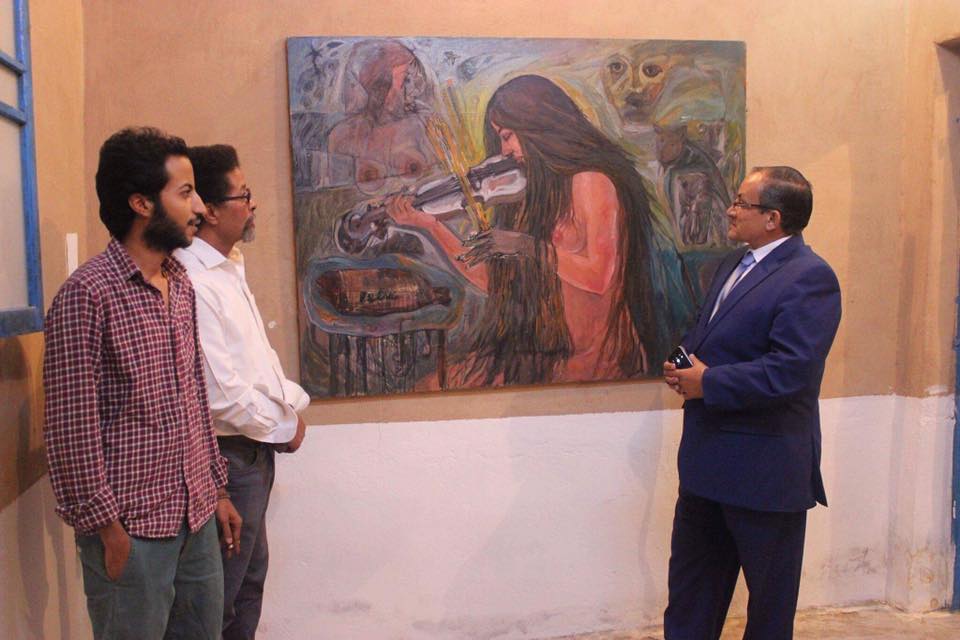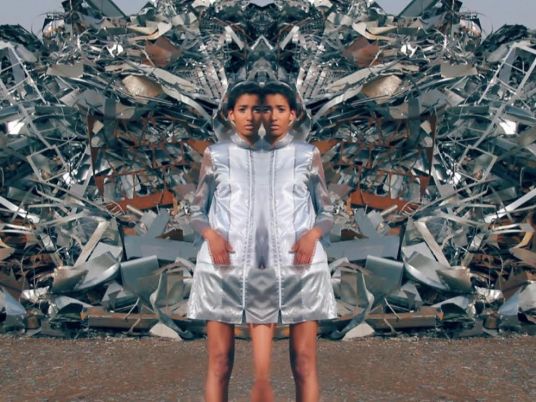Assume the Position’ is the final exhibition of the year at the Townhouse Gallery of contemporary art. The group show presents the work of ten artists and photo journalists from Egypt, Mexico, France, USA, Croatia and Lebanon. It interestingly tackles the notion of spectator-ship; the construction of vision physically and perceptually. The work satirically diverts our attention as audience from preconceived imagery often associated with the titles of the individual works to relatively minor and banal actions that provide greater contextual insights. From violent car accidents on the streets of Cairo and Mexico City to peripheral events at the 2007 G8 Summit at Heiligendamm and large scale surveillance systems in Beirut, Zagreb and Liverpool, the show adds a deeper human dimension to the tackled issues; and the conventional hierarchical roles of artist, viewer, environment and final audience are constantly shifted.
The show sets the ground for audience through a series of black and white photographs of car accidents. Photos of accidents in Cairo were hand-picked by the show’s curator Nikki Columbus from the collection of Amgad Naguib; a small art collectibles’ shop on Khadrawy Street at the Downtown area. The photographs show wrecked cars, but more importantly the crowds gathered to help out or watch. As soon as press cameras appear at the accident scenes, people automatically start posing for the camera alongside the wrecked car and sometimes even smile. People are distracted from the accident by the cameras that feed into humans’ basic desire to be seen and the construction of their self-imagery. This idea is emphasized by Mexican photographer Enrique Metinides’s photos of accidents in Mexico City, especially the two miniature photographs titled Truck Crashed into a Tree. The car accident series seem staged or surreal due to the cinematic poses of the crowds strengthening the idea of voyeurism. It also introduces the underlying theme of distraction to be continued throughout the show, explains Columbus. Accidents were caused by some kind of distraction; they in turn distract passing pedestrians, who gather around the scene. The gathered crowd is then further distracted by the cameras; and the exhibition’s audience is initially distracted from the accident by the posing crowds in the photographs.
American artist David Levine presented Specters; a group of black and white and colored photographs of public performances by renowned contemporary artists such as Paul McCarthy and Dan Graham. The photographs are titled with the name of the artists and the year of the performance. However, they present snapshots of random audience members at the performances. This approach sheds light on the audience and explores their reactions to the performances at the time. The Specters series investigates the reorientation of spectator-ship in relation to performance art rather than focusing on the actual performance, explains Columbus. Another work addressing performative art is French artist Cyprien Gaillard’s film installation Real Remnants of Fictive Wars I. The installation documents temporary land art performances, in which Gaillard sets off industrial fire extinguishers in Parisian landscapes. It criticizes man’s destructive impact on the environment. Filmed scenes are poetic and aesthetically appealing. However, they simultaneously trigger feelings of anxiety as clouds of thick white smoke gradually fill the landscapes in what seems like poisonous gases used as weaponry. The piece is strong and captivates audience members, who stand in anticipation of the next performance and its consequences. However, its relationship with the general theme of the exhibition is relatively unclear.
In the rest of the show, the concept of voyeurism is mixed with political connotations. American artist Jill Magid presents a video installation titled Final Tour. The video shows a woman in a flaring red coat taking a motor bike ride around a city. A romantic mood is set for the audience through the accompanying music of George Deleurs. On a bench at the gallery is a little red diary booklet, which asks readers to keep her diary for at least seven years. It includes a picture of the artist, personal information and dated descriptions of her thoughts, feelings and encounters for one month in 2004. However, audience is bewildered as they read the accompanying wall text. The video was actually filmed through 24-hour public surveillance cameras at central Liverpool; the largest surveillance system in the UK. Magid infiltrated the system and developed close relationships with Liverpool’s city watch during a one-month stay in the city. She succeeded in distracting the surveillance system from its primary function to film her on her bike tour around the city and guide her at times when she closed her eyes. To prevent the footage from being deleted, and have it stored in an evidence locker for seven years, she filled legal access forms. The personal and romantic diary notes in the booklet are actually copies of the access requests she filled and sent to the city watch; they show the intimate relationship, Magid developed with the surveillance officers and the city.
Lebanese artist Walid Raad also tackles political unrest in Lebanon and the division and immobility during the civil war through an emotional fable. In I Only Wish That I Could Weep, Raad presents a video of sunset at the beach promenade in Beirut. An accompanying narrative explains that the video was filmed by an anonymous Lebanese army intelligence officer assigned to monitor the area through a camera hidden in a small food stand. As a resident of East Beirut, he had never seen the sunset at the beach. Hence, he shifted the camera from the targets to the sunset every day and was accordingly expelled from service. The piece addresses civil war strife through romanticized and nostalgic ideas. Triangle by Croatian artist Sanja Ivekovic is a photographic documentation of the artist’s performance in Zagreb in 1970. The performance disrupted a procession by Yugoslavian president Josip Broz Tito. People were forbidden from going out on their balconies during the procession. Ivekovic sat in her balcony and pretended to masturbate while reading her book to provoke surveillance teams on rooftops. They immediately forced her to remain inside her apartment. The piece criticizes government repression in Yugoslavia during the seventies.
Egyptian artist Osama Dawod contributed to the show with Summit, a photographic series of minor events at the 2007 G8 summit in Heiligendamm. As part of the ART GOES HEILIGENDAMM project, Dawod joined protesters marching to the summit’s convention. He neither had a press pass nor official point of view, but was there to explore and engage with the various parties playing on commonalities rather than differences. Witnessing the procession with its mood pumping speeches, violent encounters with security forces and rising fear, he refrained from photographing the violence usually covered by news channels. Instead, Dawod, stepped back to photograph the human side of protesters and security officers. Photos included in the exhibition show protesters lost in the field as direction signs were removed by security forces to prevent people from finding the premises of the convention. Other pictures show them urinating in the field or security forces simply watching video footage of the protests. The differences between the various participants are reduced to basic human actions and feelings of anxiety, tiresome or just moments of relaxation.
‘Assume the Position’ brings together a body of works to trigger critical thought about ourselves and our environment. The concept of the show was not initially political; and it remains that way, despite the numerous pieces tackling activism and surveillance systems, explains Columbus. This show is one of the best this year and is definitely worth seeing.
Assume the Position
Townhouse Gallery of Contemporary Art
10 Nabarawy Street, Downtown, Cairo
13 December 2009 until 17 January 2010




